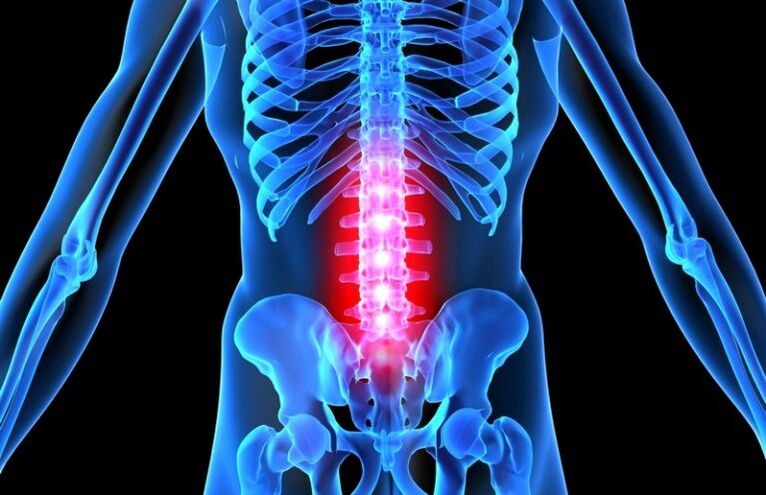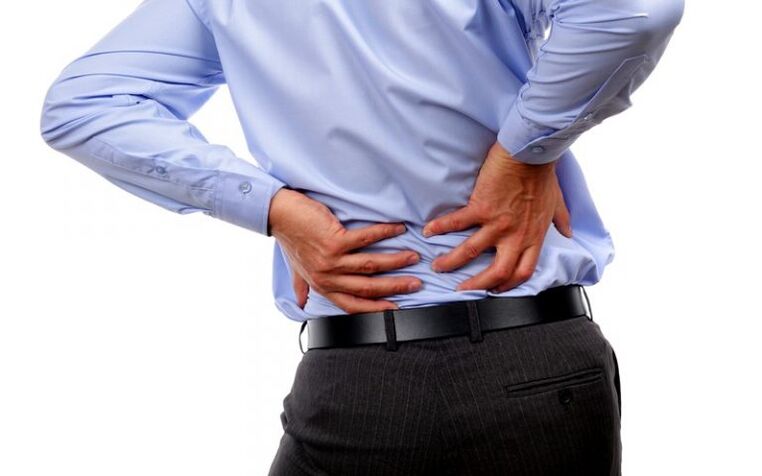
Osteochondrosis, translated from the ancient Greek, means ὀστέον - bone and χόνδρος - cartilage and is characterized by complex degenerative changes in the articular elements of the bone skeleton. Almost every part of the skeletal system is susceptible to this neurological disease. The thorax and / or cervical vertebral discs may be in the affected area. However, the symptoms and treatment of lumbar osteochondrosis are the most common in modern conditions, which is the reason for discussion and concern of practical neurologists.
Pathogenesis or development of the inflammatory process
Every growing organism changes its physiology. Thus, diffuse changes occur in the vascular bed of the intervertebral discs of the skeletal skeleton. The supply of nutrients to the spine is complicated by various traumatic conditions and / or constant dynamic loads on this part of the spine. Insufficiency of the necessary micronutrients is further complicated by osteochondrotic processes, which lead to loss of elasticity and strength of cartilage joints. With lumbar lumbar osteochondrosis, the symptoms of the disease are most active with asymmetric and irrational work of the lumbar muscles, which are found in different conditions:
- insufficient warming of muscle tissue;
- wrong posture;
- obstruction of the intervertebral joints due to excess adipose tissue;
- to use mattresses on a soft floor at night rest;
- acute mechanical and / or dynamic loads on the lumbar spine;
- physical stress;
- with exacerbation of chronic pathologies.

The supply of nutrients to the spine is complicated by various traumatic conditions and / or constant dynamic loads on this part of the spine.
If lumbar osteochondrosis is detected, the symptoms of a neurological disease due to timely medical intervention can lead to more serious neurological pathologies, such as sciatica, spinal hernia, intervertebral disc injury and other complications.
Why does lumbar osteochondrosis occur?
So far, the problem of diffuse transformations in the intervertebral space has not been fully studied. With lumbar osteochondrosis, the symptoms of neurological pathology are often felt by middle-aged people between the ages of 35-45.

Nervous overload and stressful situations can also lead to the onset of the disease.
It is at this most productive age that static and dynamic stress occurs in the spine. However, according to experts, back pain is becoming more and more troublesome for the younger age group. Thus, at the age of 18-25, young people become patients of neurological treatment departments. This is due to poor physical activity, overweight, poor posture and general deformity of the joints, which causes osteochondrosis of the spine.
Symptoms and treatment of neurological pathology, it is desirable to identify it at the earliest stage of the disease and respond to it adequately.
Other causes of lumbar osteochondrosis include:
- hereditary forms;
- insufficient supply of cartilage vessels with micronutrients;
- disorders of metabolic processes for various reasons;
- unequal development of the musculoskeletal system;
- sedentary lifestyle;
- disorders of the body associated with the functioning of the endocrine system;
- weakening of muscle structures due to the harmful effects of alcohol, smoking and other bad habits;
- the result of various chronic pathologies;
- segmental instability of the elements of the spine;
- nervous load, stressful situations and other components.
However, when lumbosacral lumbar osteochondrosis is diagnosed, the symptoms of neurological pathology in women may be due to irregularities or the development of disorders associated with hormonal changes. Between the ages of 35 and 45, the female body begins to undergo significant physiological changes that affect the functional functioning of the cartilage regions of the entire bone and spine.
Symptomatic signs of the disease
With osteochondrosis of the lumbosacral region, the symptoms of neurological pathology cause numbness, restlessness, and pain in the lower back, accompanied by aching pain in the lower back. Lack of adequate therapy can aggravate the condition and lead to complete atrophy of the lumbosacral lumbar muscle structures. Increased pain can be caused by a variety of factors, such as sneezing, coughing, sharp turns, and lifting heavy objects. Incisions in the lumbar region are most common in the gluteal region and the lower extremity. Symptoms of a neurological disease with lumbosacral osteochondrosis can be identified by the following symptoms:
- acute pain in the sacral spinal region and pelvic organs;
- loss of sensitivity;
- discomfort in the innervated muscles of the lower back;
- hypotension and hypotrophy.

All these symptoms are caused by damage to the nerve roots in the lumbar intervertebral discs.
Stages of the disease
When diagnosing lumbosacral osteochondrosis, the symptoms and treatment of the disease depend on the stage of the inflammatory process. Thus, according to the results of a diagnostic examination, it is possible to identify several specific symptoms of low back inflammation:
- The first stage is characterized by mild pain in the lower back, which intensifies under the influence of physical force. With only sudden movements, the patient feels a sharp, aching or dull pain in the back. There is no pain in a relaxed state.
- The second stage is characterized by a decrease in the distance between the vertebral discs due to compression and the onset of degenerative-dystrophic formations in ring fibrosis. Acute pain in the ankle area of the lower extremity, hips and outer thigh is caused by compression of the nerve endings between the discs in the vertebral cavity.
- The destruction of anulus fibrosis occurs in the third stage of the disease, and this is the most favorable time for the formation of a hernia in the intervertebral disc. Severe pain in the lumbar region is permanent due to significant deformations in the lumbosacral spine.
- The final, fourth stage, symptoms, treatment and rehabilitation of lumbar osteochondrosis is the most difficult in the whole process of destruction of the musculoskeletal system. This stage of the disease leads to disability of the patient, as well as complete or partial immobility.
However, any form of osteochondrosis should not cause fear or panic in a person; only appropriate adequate medical treatment is needed.
Lumbar osteochondrosis: symptoms and medications
Based on the results of symptomatic symptoms and the appropriate diagnosis according to the stage and form of the disease, specialists select the appropriate drug treatment based on the use of pharmacological compounds of different directions. The main treatment goals in solving the problem are:
- delay of degenerative-dystrophic processes in the lumbar region through the implementation of appropriate therapeutic and prophylactic measures;
- elimination of functional disorders of the spinal nerve endings;
- neutralization of painful feelings;
- functional restoration of muscle tone of the lumbosacral region;
- return of the patient to active exercise.
The patient's age and sex, as well as the condition of the endocrine system play an important role in the choice of drug treatment.
The main emphasis on drug exposure is aimed at relieving pain with the appropriate selection of pharmacological analgesics. Anti-inflammatory drugs allow you to neutralize the destructive processes in the muscle structures of the spine. The most effective pharmacological agents are non-steroidal anti-inflammatory groups.

The most effective pharmacological agents are non-steroidal anti-inflammatory groups.
With the ineffectiveness of NSAIDs (non-steroidal anti-inflammatory drugs), anesthesia with hormonal supplements and / or paravertebral blockade is used. In addition, the complex drug process includes other types of pharmacological drugs, such as sedatives, muscle relaxants, groups of drugs containing vitamins B1 and B12, which eliminate the effects of contractions and provide nerve tissue with micronutrients. At the end of the acute inflammatory period, treatment is completed with medication, and other therapeutic and prophylactic measures are applied during remission.
Therapeutic prevention of lumbar osteochondrosis
You should know that the treatment of osteochondrosis is a complex process that requires strict discipline and strict adherence to all prescriptions of the attending physician. One condition for the full recovery of the body is to carry out all stages of complex treatment:
- Massage that helps to relieve muscle pain, restore blood circulation in problem areas of the back, relieve muscle tension in these areas of the body.
- Physiotherapy is an excellent tool for rehabilitation after illness. These are the advantages of the absence of side effects, the elimination of residual stress in the lumbar region, physiotherapy procedures.
- Manual therapy can have a measured mechanical effect on the lumbar muscle tissue and provide improvement in all vital processes.

It should be remembered that failure to follow the recommendations of a neurologist for the complex therapeutic treatment of lumbar osteochondrosis is a possible appointment with a surgeon. In 90% of cases, surgery on parts of the spine is the result of neglect of the disease and non-compliance with the recommendations of the attending physician.

























